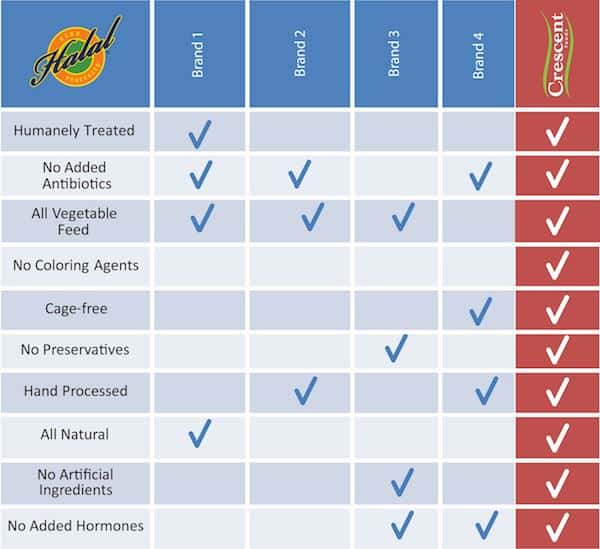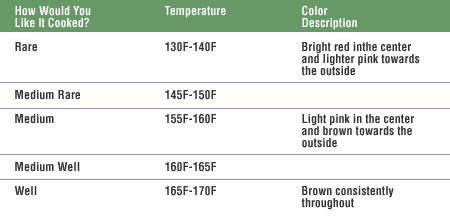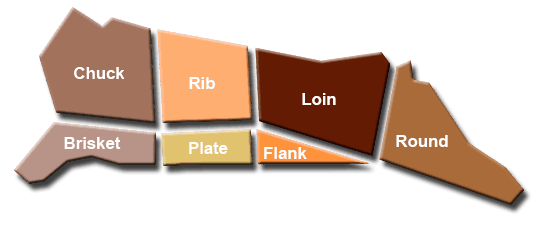Crescent Foods
Frequently Asked Questions
Did You Know
You asked, we delivered! Here at Crescent Foods, we are working with various farmers to meet your demands and satisfy those chicken cravings. We continue to have the same natural and quality attributes from the very start and therefore are committed to providing you with products through the utmost trust, integrity and quality. Our products are hand harvested, humanely raised, vegetarian fed with no animal by-products, free of antibiotics and hormones, and are raised cage free.
We are committed to providing you with products 100% FREE OF ANTIBIOTICS. We started this journey in 1996 and have been consistent with our values. What does no antibiotics mean? Our antibiotic-free chickens are grown on local farms by family farmers chosen due to their commitment in raising healthy animals WITHOUT the use of antibiotics
Like us, birds come in various shapes and sizes. The size of the bird is contingent upon the number of days.
It is our ethical responsibility to provide the utmost care for our animals. All chicken houses consist of controlled, cage-less areas that provide adequate space, fresh air, and clean water that is readily available for all our chickens. We are dedicated in providing our chickens with an all-natural feed and ensuring they are raised in a safe and comfortable environment.
By carefully hand-deboning fresh chicken products, we can ensure superior quality consistently across all our offerings. This manual process allows us to control the cuts of meat and improves the overall quality of bone removal in comparison to mechanical methods.

Chicken FAQ's
On a frequent and regular basis, the Shar’i Zabihah Committee of Islamic Social Services conduct random inspection visits to Crescent Foods’ Slaughtering and Processing facilities to determine Halal compliance. They renew this certificate only after a thorough, certified inspection is complete.
All Crescent products are certified to be pure Halal by the highest national standards set in North America and around the world. This means the birds are raised on all-vegetarian feed, they are treated and processed in the most humane of ways, and are free of preservatives, artificial ingredients, hormones, antibiotics and color additives.
You can rest assured that we would never compromise on the Halal guarantee at any step of the process, from Farm to Fork. Pure & Simple®

Halal is an Arabic word that means permissible. Halal products are healthy, offering natural goodness for you and your family.
Halal protein products should be made from humanely treated animals that are raised and processed in a gentle environment and clean conditions.
If you are concerned about the highest standards from Farm to Fork, be sure to look for Crescent Foods’ Halal symbol on the package.
For further information about Halal Products and Services, visit http://www.americanhalalassociation.org/
Chicken may be frozen in its original packaging or repackaged into smaller portions. However, if it will be frozen longer than two months, place it in airtight plastic or freezer containers. If your chicken is not properly wrapped, air can reach the surface and cause freezer burn. Discard heavily freezer burned chicken because the meat will be too dry and tasteless.
The USDA recommends three different ways to defrost chicken: in the refrigerator, in cold water and in the microwave. Never defrost chicken on the countertop.
In the refrigerator: Slow but safe. Boneless breasts usually defrost overnight. A whole bird may take up to two days. Once it is defrosted, it can be kept in the refrigerator another day or two before cooking.
In cold water: Be sure the bird is in airtight packaging. Submerge it in cold water, changing the water every 30 minutes. A package of parts will defrost in 2 to 3 hours; boneless parts often take less time.
In the microwave: Cook immediately after thawing because the food may become warm during microwaving.
Crescent Foods practices safety procedures over and above that which is required by the U.S. government.
In order for you to continue safe handling before you serve any poultry to your family, here are some guidelines to follow:
- Make the grocery store your last stop before returning home.
- Select fresh chicken just before checking out.
- At home, refrigerate the chicken immediately and use it within two days. Or freeze it.
- Always wash hands, countertops, cutting boards, knives and other utensils with hot soapy water before they come in contact with other raw or cooked foods.
- Do not use the raw chicken marinade as a sauce poured over cooked chicken.
- To check visually if the chicken is done, pierce chicken with a fork. Juices should run clear – not pink – when fork is inserted with ease.
- Never leave cooked chicken at room temperature for more than 2 hours. If not eaten immediately, cooked chicken should be kept either hot or refrigerated.
- If you’re transporting cooked chicken, put it in an insulated container or ice chest until ready to eat. Keep below 40°F or above 140°F.
Before you cook:
Choose all your fresh meat last when you are grocery shopping. That way it will stay cool until you get home.
Never leave chicken in a hot car or on your counter top warming up to room temperature. Keep it in in the coldest part of your fridge.
We recommend you use it within two days. If you don’t, then freeze it.
Thaw it in the fridge or place it in a plastic bag and submerge in cold water.
Change the water often. Before you prepare it, be sure to wash your hands, cutting board, and utensils.
Be sure to cook all poultry to an internal temperature of 165 degrees F.
The juices should run clear, not pink.
After you cook:
Don’t leave leftovers at room temperature longer than 2 hours. Either keep them hot, or refrigerate them.
Cooked chicken is best refrigerated no longer than 2 days.
If you reheat it, cover it to retain moisture.
Crescent chicken has less fat.
Depending on your cooking method, you may want to keep the chicken covered in order to keep it moist, or add a bit more of your marinade.
Remove the cover toward the end in order to brown.
Crescent chickens taste better than other chickens you may have had because they do not need to be masked with heavy sauces or coatings. Lighter marinades do the job just fine.
The National Chicken Council forecasts the American per capita consumption of chicken at over eighty pounds a year.
Wouldn’t it be a good idea if that eighty pounds was as good… and as good for you… as it can be?
That’s why you need Halal chicken from Crescent Foods.
Did you know that most commercial chickens are raised in overcrowded chicken houses. The opposite end of the spectrum is “free range” where chickens are given access to the outdoors.
Crescent chicken is neither.
Our birds are raised in flocks, in roomy barns with plenty of sun and fresh air.
Because they can move freely, they develop muscle with superior fiber. That results in superior flavor.
Unlike many free range birds, we can control what our birds eat.
So we know they only get rich, nutritious grains: a 100% healthy vegetarian diet.
Everything we do for our birds results in healthier, cleaner meals for customers and family.
It’s simply a fact that it costs more to raise chickens the way we do and to process them quickly, humanely, free from any kind of additive whatsoever.
But the time and care we take results in finer flavor, less fat and better fiber.
You could pay less for chicken that includes artificial ingredients, injected oils and fats, coloring agents and added water and flavorings.
Can you think of a reason your customers or your family should be eating those? Neither can we!
Most of you will never have tasted chicken this fresh, clean and nutritious before.


One pound of raw chicken with bones yields 1 cup cooked, boned meat.
Store-bought rotisserie chicken is convenient, but may be 3 to 4 times higher in sodium than a home roasted bird due to the marinades used.
Chicken thighs are slightly higher in fat, but are more flavorful and juicy.
To prevent chicken skin from bubbling, poke fork holes in it before grilling.
If you start grilling with the bone side down, you are less likely to burn the bird.
Marinate chicken in the fridge, not at room temperature.
Discard the liquid that you use to simmer the bird and replace it with a low-fat sauce.
Grilling allows fat to drip away. When oven roasting, don’t let the bird sit in the drippings; use a grid or rack in the pan.
You can thicken gravy or stew with pureed cooked vegetables instead of fat and flour.
Use yogurt instead of mayo in chicken salad.
Cook more chicken than you need. Use the leftovers in low fat sandwiches for the kid’s lunches.
Frying chicken? Refrigerate the coated parts, uncovered, for up to an hour before frying. The coating will stick better.
Add a little bran or wheat germ to your coating mixture; it adds fiber as well as texture.
Angus Beef FAQ's
Larger frozen cuts will keep better and longer with less flavor change, than smaller frozen cuts. As a general rule, no longer than 6 months, although raw ground beef should be eaten within 2 months. Cooked meat can be frozen for 1-2 months.
If possible, plan ahead when intending to use frozen meat. The best way to maintain quality of frozen meat is by slow thawing in its existing wrapping in the refrigerator or chiller.
Allow the following approximate thawing times in the refrigerator:
Large roast: 4-7 hours per 500 grams
Small roast: 3-5 hours per 500 grams
Steak, 2.5cm thick: 12-14 hours
Ensure there is no possibility of meat drip during thawing ,by placing meat on a tray at the bottom of the refrigerator. This prevents contaminating other foods in the refrigerator.
Thawing meat at room temperature is not recommended. The meat surfaces may reach temperatures warm enough to encourage microbial growth. Temperatures above 158 Fahrenheit. are especially dangerous as they can allow the growth of pathogens such as Salmonella if present on the meat.
Fresh cuts may be kept up to 10 days if packaged correctly and kept at low temperatures
No. This is illegal.
Lean muscle fibers in meat are made up of 50-75% water. This natural moisture in meat contributes to its juiciness. Some water is driven out of meat during cooking therefore the longer the cooking, the more water is lost. If cooked too long, very lean cuts can lose much of their moisture, resulting in very dry meat.
Refrigerate or freeze ground beef as soon as possible after purchase. This preserves freshness and slows growth of bacteria. Make sure your refrigerator is at 40°F or colder, and use refrigerated ground beef within 2 days.
For storing in the freezer for longer periods, wrap ground beef securely in heavy duty plastic wrap or foil. Assuming your freezer is at 0°F, ground beef stored this way should be fine for a couple of months. Make sure you mark the packages with the date you froze them so you don’t forget how long they’ve been in there.
Grass-fed beef cooks faster – so cook it for less time. Grass-fed beef cooks a little faster than ordinary beef, and also shrinks less, because it’s leaner. Seasonings, sauces, and sides will likely add more flavor to grass-fed beef dishes, because your taste buds don’t get coated with beef fat.

This indicates that no antibiotics were used on the animal in its lifetime. Antibiotics are used to prevent and treat disease in animals – just like in humans. If an animal does have to be treated with an antibiotic for illness, our meat cannot be sold in a naturally raised system and cannot have a label with the wording “antibiotic free”.
In New Zealand, all commercial hand processing of livestock, including Halal processing, must be undertaken in a humane manner in accordance with New Zealand’s animal welfare laws. Even as the animals raised give us sustenance, they deserve respect and dignity as they live their lives. Because of this commitment, cattle has the right to natural grazing patterns and our growers strive to keep them relaxed and content so they live a happy life.
Cuts of beef can be broken down into three sections. Starting on the upper back and moving down to the mid-back you have the rib, the short loin and the sirloin. The rib contains cuts such as the Rib Roast, the Rib-eye Steak and the back ribs. The short loin produces the T-bone, Top Loin Steak, Tenderloin and the Porterhouse. The Sirloin gives the Sirloin Steak, and the Top Sirloin. Other steaks like the chuck, round and flank steak come from those respective areas. Strips steaks, like the New York Steak is cut from the T-bone portion.
Please refer to the chart below to gain a better idea of where beef cuts come from.

Lamb FAQ's
Our lamb products are raised in New Zealand
Yes all of our products are Certified Halal Hand Harvested
Being raised solely on grass is better for the Lamb and for you! Grass-fed lamb is lower in fat and contains more vitamins and minerals, which allows our products to not only taste great, but also be actually good for you!
